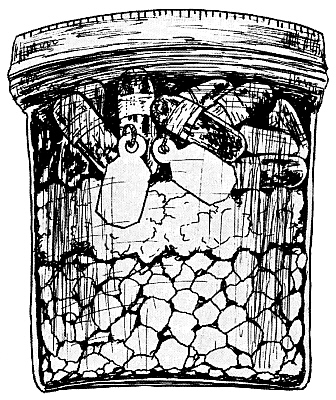Storage Of Pollen And Seed

|
|
Calcium chloride covered by a layer of cotton
can be replace by dried milk rolled in facial tissue as a desiccant for storage of seed or pollen. |
Dr. James Harrington of the University of California has recently developed a method of storing seed using dried milk as a dessicant. The hygroscopic property of powdered milk soaks up moisture which might cause the seed to spoil.
The method Dr. Harrington recommends is extremely simple. Roll up two heaping tablespoons of powdered milk in four facial tissues placed on top of each other, and hold in place with a rubber band or tape. This is put in the bottom of a screw top jar having a rubber ring to make it air-tight. Seed packets are placed on top of the roll and the jar kept in the refrigerator. Powdered milk will quickly pick up moisture from the air when the jar is open so when packets are removed the jar should be resealed promptly.
According to Dr. August Kehr, this method will work for rhododendron seed. In fact, after the seed is dried over the powdered milk for 3 to 4 days, the seed can be placed in the freezer.
1
In addition, the powdered milk can be used to replace calcium chloride as a desiccant for storing pollen, Dr. Kehr says, using the method he published in the July 1966 issue of the Bulletin.
(This issue is out of print. The portion of Dr. Kehr's article about the storage of pollen is reprinted below. ED)
Collecting and Storing Pollen
Inexpensive and practical techniques are today available to every breeder. They enable him to store rhododendron and azalea pollen almost indefinitely, even to the point of approaching suspended life. Such storage of pollen permits us to make any pollination desired, despite months of time differences in blooming, and despite the fact that continents separate the parents.
Successful pollen storage techniques have been reported for asparagus (14), for various tree fruits (5), and for many other plants including rhododendron (15). Following these methods, I have made successful crosses of deciduous and evergreen azaleas, and scaly and non-scaly rhododendrons, using pollen ranging in age from 1 to 3 years. Briefly, this technique is as follows:
(1) Collect anthers, preferably just before the flower opens, and put them in labeled gelatin capsules. These are available at most drug stores. Number 1 capsules are about the right size. Avoid large sizes; they are difficult to use in making crosses on small flowered sorts.
(2) Pre-dry pollen, within the capsules, for 2-3 days in a home refrigerator. This pre-drying step may be very essential prior to freezing. (3) When thoroughly dry, store in sealed jars, over calcium chloride, in the freezer compartment of the refrigerator at about 0° F. (-17° C.) It may be of interest that when stored at -374° F. (-190° C.), the pollen may keep indefinitely (15).
To use the stored pollen merely warm the container and make pollinations as needed. The sudden warming does not seem to injure the pollen, neither does repeated thawing and refreezing. Tapping the capsules almost completely empties the dried anthers of their pollen. The pollen usually adheres to the walls of the vial, making cross-pollination even easier to effect in some cases than with fresh pollen. The dried and stored pollen can be used by inserting the pistils directly into the capsules.
1 Dr. August Kehr - private correspondence